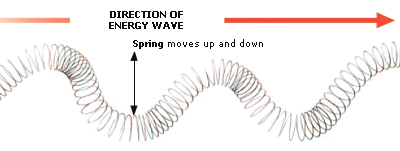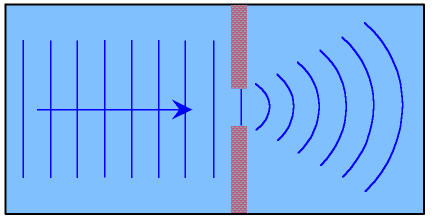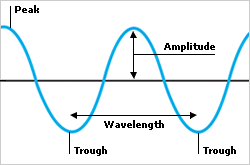WAVES REVIEW
- Click on highlighted words as you come across them to complete activities.
- Review the VOCABULARY terms & definitions.
WAVES have three important measurements:
- AMPLITUDE - height of a peak or trough
- WAVELENGTH - distance between any two peaks or troughs.
- FREQUENCY - number of waves that pass by in one second
What are waves?
Waves are vibrations that transfer energy from place to place without matter (solid, liquid or gas) being transferred. Think of a Mexican wave in a football crowd: the wave moves around the stadium, while each spectator stays in their seat only moving up then down when it's their turn.
Some waves must travel through a substance. The substance is known as the medium and it can be solid, liquid or gas.
Sound waves and seismic waves are like this.
- They must travel through a medium, and it is the medium that vibrates as the waves travel through.
- Visible light, infrared rays, microwaves and other types of electromagnetic radiation are like this. They can travel through empty space.
- Electrical and magnetic fields vibrate as the waves travel.
You should be able to describe the characteristics of transverse and longitudinal waves.
Transverse waves
In transverse waves, the oscillations (vibrations) are at right angles to the direction of travel and energy transfer
- Light and other types of electromagnetic radiation are transverse waves. All types of electromagnetic waves travel at the same speed through a vacuum, such as through space.
Water waves and S waves (a type of seismic wave) are also transverse waves.

Longitudinal waves
In longitudinal waves, the oscillations are along the same direction as the direction of travel and energy transfer.
Sound waves and waves in a stretched spring are longitudinal waves.
- P waves (relatively fast moving longitudinal seismic waves that travel through liquids and solids) are also longitudinal waves.

Suppose you fix a slinky spring at one end & push the other end back & forth. Some parts of the spring, called compressions are squeezed together. Other parts of the spring, called rarefactions are stretched out. The compressions & rarefactions travel down the spring carrying energy. This type of wave is called a longitudinal or compression wave.
Amplitude, Wavelength and Frequency
You should understand what is meant by the amplitude, wavelength and frequency of a wave.
Amplitude
As waves travel, they set up patterns of disturbance. The amplitude of a wave is its maximum disturbance from its undisturbed position. Take care: the amplitude is not the distance between the top and bottom of a wave.
Wavelength
The wavelength of a wave is the distance between a point on one wave and the same point on the next wave. It is often easiest to measure this from the crest of one wave to the crest of the next wave, but it doesn't matter where as long as it is the same point in each wave.
Frequency
The frequency of a wave is the number of waves produced by a source each second. It is also the number of waves that pass a certain point each second.
The unit of frequency is the hertz (Hz). It is common for kilohertz (kHz), megahertz (MHz) and gigahertz (GHz) to be used when waves have very high frequencies.
- For example, most people cannot hear a high-pitched sound above 20 kHz, radio stations broadcast radio waves with frequencies of about 100 MHz, while most wireless computer networks operate at 2.4 GHz.
Check your understanding of this section by having a go at this activity. Click wave
The speed of a wave is related to its frequency and wavelength, according to this equation:
v = f × λ
- v is the wave speed in meters per second, m/s
- f is the frequency in hertz, Hz
- λ (lambda) is the wavelength in meters, m.
All waves obey this wave equation. For example, a wave with a frequency of 100 Hz and a wavelength of 2 m travels at 100 × 2 = 200 m/s.
Check your understanding of the equation by having a go at this activity.
All waves obey this wave equation. For example, a wave with a frequency of 100 Hz and a wavelength of 2 m travels at 100 × 2 = 200 m/s.
Refraction and Diffraction
The refraction follows a regular pattern. Check your understanding of refraction by having a go at the animation.
Waves can be refracted and diffracted.
Refraction
Sound waves and light waves change speed when they pass across the boundary between two substances with different densities, such as air and glass. This causes them to change direction and this effect is called refraction.
There is one special case you need to know. Refraction doesn't happen if the waves cross the boundary at an angle of 90° (called the normal) - in that case they carry straight on.
- the phenomenon of refraction — that when light travels across the border of two transparent media (such as air, glass, Lucite, etc.), the path of light bends.
- light is made up of waves, and that waves at different wavelengths create different colors.
- a prism sorts a light beam into its various wavelengths, appearing as a rainbow of colored light.
- there are waves that cannot be seen by the human eye that affect our daily lives.
- For example, we wear sunscreen and sunglasses to protect our skin and eyes from ultraviolet waves.
Diffraction
When waves meet a gap in a barrier, they carry on through the gap. However, the waves spread out to some extent into the area beyond the gap. This is called diffraction.
The extent of the spreading depends on how the width of the gap compares to the wavelength of the waves. Significant diffraction only happens when the wavelength is of the same order of magnitude as the gap. For example:
- a gap similar to the wavelength causes a lot of spreading with no sharp shadow, eg sound through a doorway
- a gap much larger than the wavelength causes little spreading and a sharp shadow, eg light through a doorway.

Reflection
Sound waves and light waves reflect from surfaces. When waves reflect, they obey the law of reflection:
the angle of incidence equals the angle of reflection
- The normal is a line drawn at right angles to the reflector
- The angle of incidence is between the incident (incoming) ray and the normal
- The angle of reflection is between the reflected ray and the normal.
You need to label an example of the LAW OF REFLECTION.
Smooth surfaces produce strong echoes when sound waves hit them, and they can act as mirrors when light waves hit them. The waves are reflected uniformly and light can form images The waves can:
- appear to come from a point behind the mirror, for example a looking glass
- be focused to a point, for example sunlight reflected off a concave telescope mirror.
Rough surfaces scatter sound and light in all directions. However, each tiny bit of the surface still follows the rule that the angle of incidence equals the angle of reflection.



